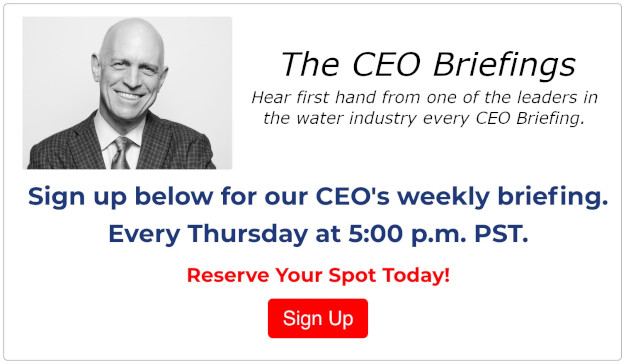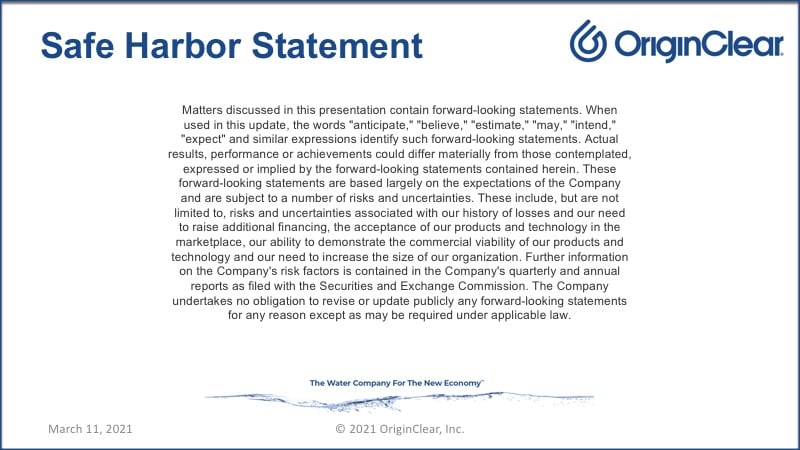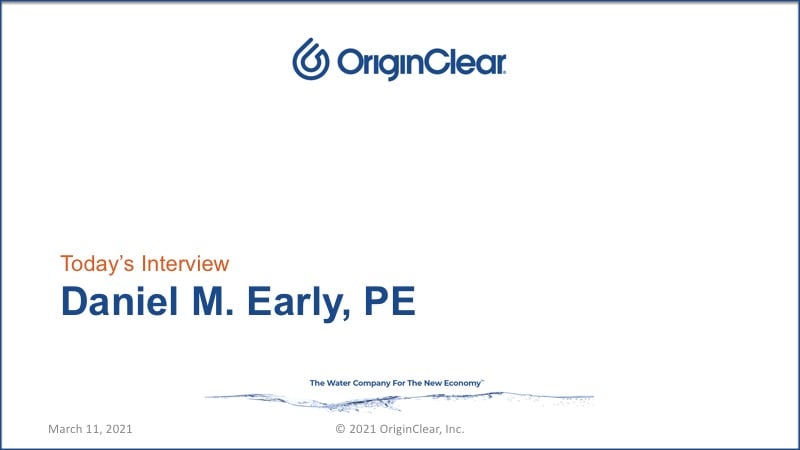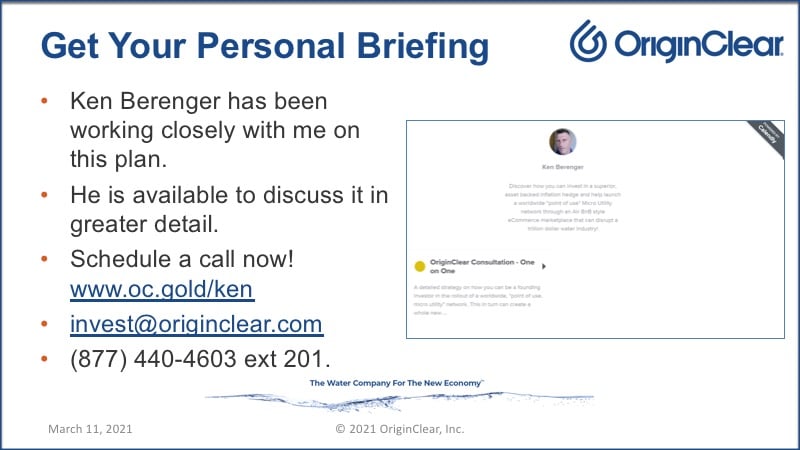Insider Briefing of 11 March 2021
Why do we call it the next generation of Water as a Service? And why is it now our single focus and strategy? Our own Dan Early, private water industry guru, gave us an eye-popping report on just what it means to the deals in his pipeline...Catch the replay here for the full scoop!
FEATURED OR COVERED IN THIS BRIEFING — QUICK LINKS
- What is DBOO (Design-Build-Own-Operate)and why is it favored in the public and now private water industry sectors?
- Why does DBOO have a higher expectation of performance and how does this relate to OriginClear?
- How financing is key to a DBOO and Dan Early's take on how it could affect us.
- How acquiring water systems will be just like buying a car with our new model.
- Dan discusses the advantage a DBOO give us over the competition and how it eliminates risk.
- How our use-based model enhances the traditional DBOO model even more.
- How our Modular Water Systems improve the Rent-a-Center model to a point that Dan Early calls it a convenience model.
- What is Basis of Design, how it changes the whole biz procurement game and why Dan Early has so many projects that are Basis of Design.
- The number of early-stage deals in Dan Early's pipeline and his estimation of what OriginClear Financial funding would mean to capturing them.
- Why Dan feels OriginClear's new single point-of-contract DBOO model is the most cost-effective way of doing business and the impact it will have.
- Why our new model won't bottle neck on delivery and projects can be farmed out to existing allied companies.
- Creating a "gold-standard" of certified water treatment systems for our DBOO model.
- How our Water on Demand program can kick the Water as a Service model up a notch.
- Various aspects of managed services and how we would manager a water technology.
- Our Regulation A offering for almost everyone.
- A sneak-peek at Ken Berenger's wild new presentation.
- Water: the new asset class.
Transcript from recording
Introduction
Riggs Eckelberry:
Good evening, everyone. It's a great pleasure to have you on our hundred and first show and I'll be starting it without further ado. Welcome, welcome. I just have better and better news each time, we're moving extremely fast and I think you'll enjoy this very much.
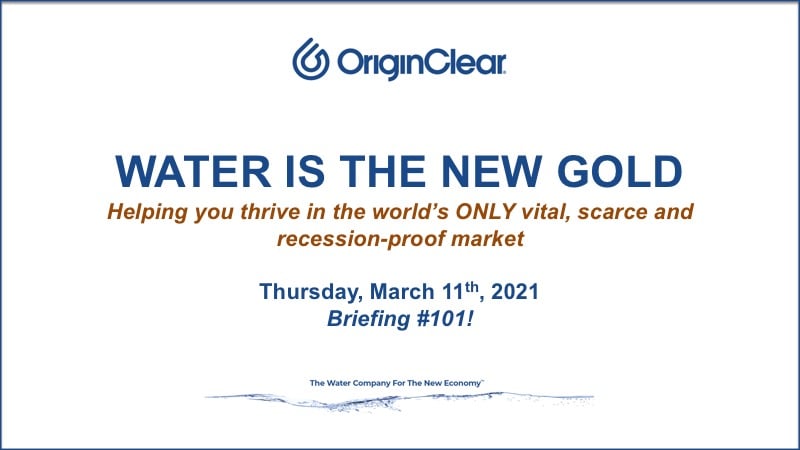
New Asset Class
So, Water is the New Gold and it is of course this new asset class that we're so excited about that is being revved up by what we call Water on Demand™, that is, pre-funded systems delivered as a service on the meter, Water as a Service (WaaS) upped [to] the next level for reasons that we will be discussing very shortly.
Forward Looking Statements
Okay. It is Thursday, March 11th, briefing number 101. God, I haven't been on the 101 freeway in a long time. All right. So, safe harbor statement of course is that we do our very best to say what's going to happen, but of course there are uncertainties that we will try to remedy as we go.
Featured Guest: Dan Early
Okay, tonight I had Dan Early, he's in a closing meeting with some customers tonight. And so I grabbed him before that. And I'm now going to run that. So sit back, relax. This is an amazing story.
Start of video presentation
Transcript from recording
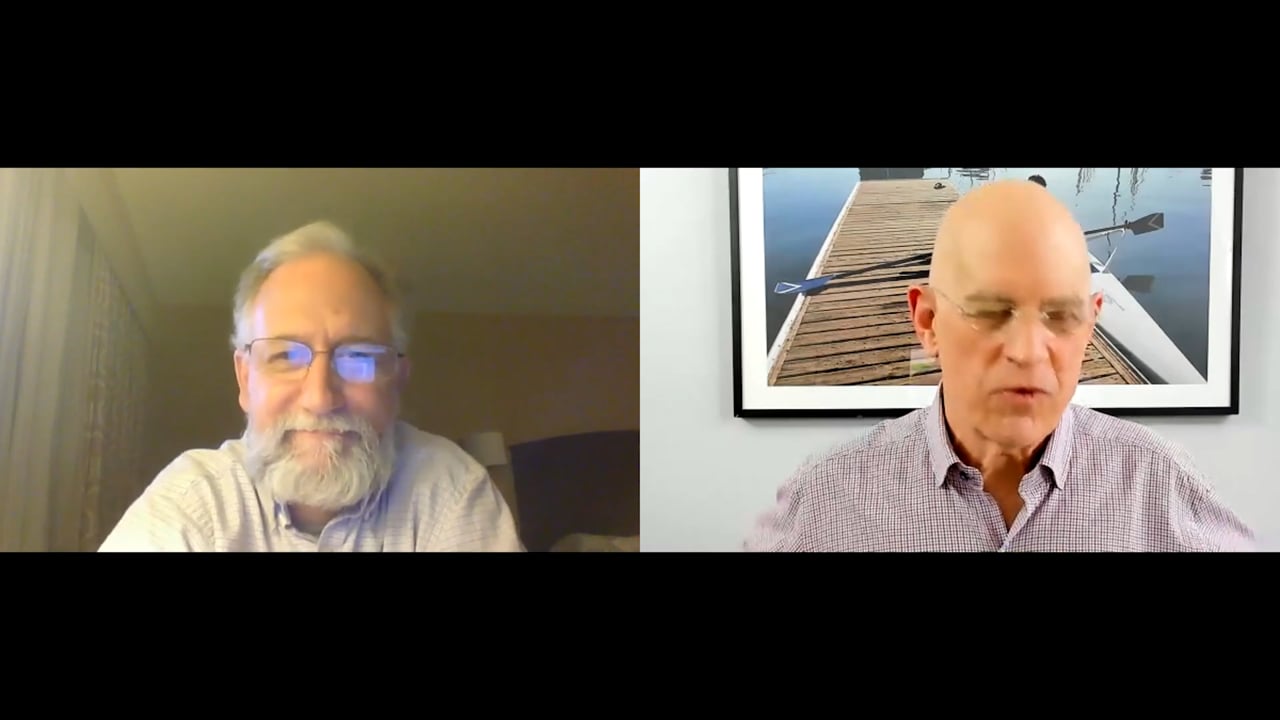
DBOO Design, Build, Own and Operate
Riggs: Well, good evening Dan and welcome to the show. We're pre-recording this, because I understand that you have follow-up meetings with people you presented to today, in Pennsylvania was it?
Dan: I'm in the Panhandle of Florida today.
Riggs: Oh, fantastic. Oh, I love it up there, Tallahassee area, stuff like that.
Dan: Pensacola, Pensacola and Navarre Beach, Fort Walton. Fantastic.
Riggs: I love it. Yeah, no, I've actually gone fishing down there and some really nice fishing. Okay. Well, thank you very much for taking a little time for us. And I wanted to talk quickly about a topic, which you know very well of DBOO, can you break that down for us please?
Favored in Public and Private Sectors
Dan: Yeah, I'd be glad to Riggs, a DBOO is terminology in the water industry used to describe the design, build, own and operate business model. So what that means is, it's just a quick, fancy, short term word for, "Hey, we build, design, own and operate utility systems." It's just a fast delivery model, very effective delivery model. It's a delivery model that has been a mainstay in the industry now for at least 15 years. It's been around for quite a while. It's found a lot of favor public sector and it is finding a lot of favor in the private sector now.
Riggs: So it grew out of municipal contracts that might be for example funded by a bond or a bank and then of course it's trickled down to private. And, but now of course, how do the private parties get their funding to do this? So that would seem to be the bar, right?
Dan: It is, in the private sector when you're dealing with decentralized utilities, sometimes customers they have a need. They have a need for a water system or wastewater system, but they may not have access to functional capital or they're not credit worthy or that type of thing. And they can't go through conventional lending models in those venues.
When you have a design-build-own-operate model, where you have a very, very good control of the business plan and the business model and the assets that are being deployed and being utilized by the end user, that makes it a much more fundable enterprise... the risks are better managed is the best way to describing that. So there's upsides.
High Expectation of Performance
Riggs: Well, okay. And so DBOO, you're implying also that these are standardized products so that there is a high expectation of performance, right? You're not experimenting because hey, you're guaranteeing a certain amount of productivity and you're getting paid by productivity.
I often like to talk about how my company OriginClear for each one, a seat that we have, we're paying more each year than we would pay, used to pay for Microsoft office back in the day, one time. But on the other hand, we get much more service. We expect unlimited cloud and all the debug and everything. So it may be more profitable model, but it also is more accountable and you can get in trouble with that. And that's why I'm interested in why... the technology that you've pulled together as chief engineer now for almost three years makes such a difference for the DBOO model.
Dan: Well, if you recall from all the previous conversations we've had, we've had this intense focus on standardization and productization. So now the way we build and deliver our equipment systems to our customers, it's a very streamlined approach, a very streamlined process. It is not this clunky, protracted design, build and deliver model. It show's up, it's ready, it's plug and play.
Financing is Key
Well, when you can bring the financing model with that, now this is very, very easy. This is not unlike going down to the local car dealership and if you want to buy a Ford pickup truck, you just say, "All right, I want the Ford F-150, I want the King Ranch edition, I want it in this color, check the boxes" and they'll set you up. They'll lease it or fund or whatever, set up the financing program and you drive it off the lot.
And so that is what this design-build-delivery model is. We are to that level with the completeness of the equipment. And now by leveraging this design-build-delivery model with the funding capability that goes with it, this is going to make water available and wastewater available for people that didn't have access to it before.
Riggs: Yeah, that's huge. I've been talking in fact to a good friend of mine who operates a nice $12 million business in Mexico, literally trucking wastewater away from corporations. So they get that little piece of paper that they can show the municipality that, "Hey, I didn't dump any water." And he's so excited about putting water systems at each of those clients, treating it. And now he's only trucking away the sludge, which is less than 1% of the total. And of course, now we come to finance, right? That's the next thing. Otherwise, we'll still be talking two years from now. It's just how it is, right?
Dan: That's right.
Riggs: How many deals do you have that you've been talking since 2019, 2018, right?
1/3 of the Deals
Dan: I will tell you. Yeah, that's right and earlier, I will say right now Riggs that as we stand here in 2021, in March 2021, I would dare say that at least a third of the wastewater treatment opportunities that we are actively engaged and have met with, presented to, quoted and at various stages of moving through permitting, I would say at least a solid third of those would be viable candidates for the design-build-own-operate; these private sector customers, especially I'll tell you in the last 12 months with COVID and the way the business world has been turned on its heels with COVID.
Like Buying a Car
I will use the campground, the RV park and outdoor recreational customers that need water, wastewater, decent flush water, wastewater; they are the ones that we are finding, are asking us, "Can you do it all? Can you design the equipment? Can you deliver the equipment? Can you construct and commission, and can you finance?"
When they're asking, it's like buying a car. That's the vision that they have, that's the simplicity. One single point of delivery. That's the key to it. It is very streamlined, it is very efficient in how you service the customer and deliver their need.
Eliminating the Competition
Riggs: So in these small to medium sites that we are really working with like the RV, campground and so forth, that are booming by the way, of course. If you offer that kind of comprehensive package, how much competition do you have now?
Dan: It really does carve out, it really firewalls you from people coming in and picking you off. When it's purely a bid-based delivery model, that just opens the door to competition, cut-throat competition, and it confuses the customer. They're getting quotes from other people or from other contractors, this delivery model stays focused.
Riggs: And people lie.
Dan: And people lie. Exactly, people lie. So this stays centered and focused on our capability, our product function and how we service, and interact, and work with the customer. And basically, it's a relationship. It's built on trust, and it's a relationship built around trust and confidence that we'll be able to deliver the system we need to the customer, to do what it needs to do.
When you do that and you throw in the funding model, it really shields us from everybody else. It eliminates that risk that comes with that. The other guys would have to duplicate exactly what you do, and what we do is not easy to do. This is a very protracted, long build out, and we are getting there. We're there. We're there now.
Riggs: Not to mention the capital, right?
Dan: Right, exactly.
Riggs: He who has got the gold makes the rules, right?
Dan: He who has the gold makes the rules.
Enhancing the Model
Riggs: Now, you're talking about DBOO, which is not necessarily a metered model. It could be a conventional system that's being financed, right? Just like the car being driven off the lot, being financed by OriginClear Financial.
Dan: Yes sir.
Riggs: Now we go to the next step to Water as a Service® (WaaS). You install a meter at the site, you say, "Mr. Jones, pay on the usage you have and here's your rate," and they sign. At that point, it's entirely use-based. How further does that enhance the model?
Dan: It definitely enhances it because, it is making things so much easier for everybody to understand. It really makes it easy for them to get their brains wrapped around it. That's the biggest thing.
Riggs: Right, because we're eliminating all the credit stuff. We're saying, "Look, it remains our equipment, we're going to put it on site. And by the way, being Modular Water Systems™, we can easily roll it in, roll it out. You stop paying, it goes away."
Dan: Yeah. That's right.
Convenience Model
Riggs: It's the Rent-A-Center model, right? So at that point, our risk goes way down. They don't have to jump through hoops on credit and so forth, and they only pay for what they use. Now, it's relatively more, but it's in dribs and drabs. It's a landlord model, right? You're just paying payments.
Dan: It is. It's a convenience model. That's the best way I'd describe it. When you use the Rent-A-Center and water-on-demand and that type of thing, it is a convenience model is what this means. It is simplified, it's easy, it's convenient.
I'll tell you, water and the water world and what the end users, the customers, that's what they want. They want it to work, they want to trust and believe in it, and they want it to be convenient, and they will pay for that. They will.
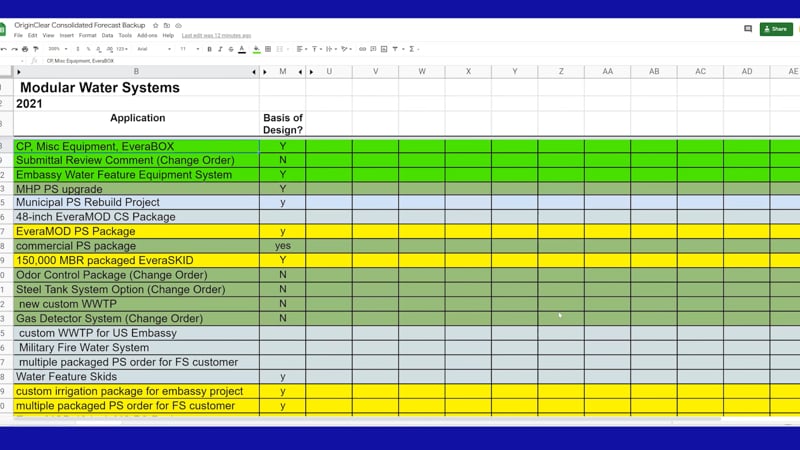
2021 Sales Forecast
Riggs: I've shared the screen here due to... This is your actual forecast. I've taken out the dollars and the percentages and so forth. But what we have here is your 2021 forecast, and really what we have here is what they are. Like EveraBox I think is a tank. Is that right?
Dan: The EveraBOX™, that is our modular equipment dealing... It's a complimentary piece of equipment that we supply with some of our systems.
Riggs: Okay, cool. And then we have, we do a lot of work with embassies as we know, MHP, that's the Mobile Home Park, municipal pump station. What's the EveraMOD™?
Dan: The EverMOD, that is our standardized pump station product line.
Riggs: So I have to call Everamod, not Very Mod?!
Dan: EveraMOD. No, Evera, EveraMOD.
Riggs: Potato, potato.
Dan: That's right.
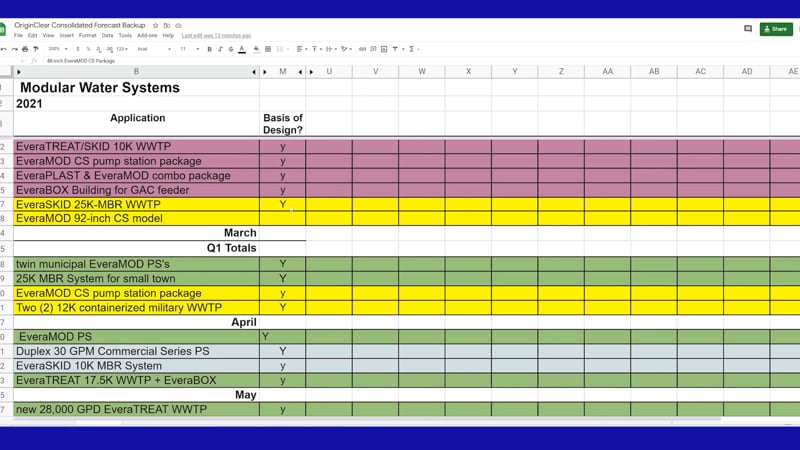
Basis of Design
Riggs: These are various systems that we're going through here, and it is no secret that the totality of this is well into the eight figures. What's cool is, what's this basis of design, yes, yes, yes? What's that all about?
Dan: So basis of design, when a customer has a specifying engineer operating or serving as their agent, and that engineer evaluates our technology and recommends our technology as the preferred delivery model, we effectively at that point, we become "basis of design."
That means we have been chosen, we've been selected, we're going to be made a part of the permitting and the construction document package. It's a more formalized approach to sealing the deal is what it boils down to.
Riggs: So they have basically stated, your design, the Modular Water Systems design is how we're going to build the system. And since we have licensed your patents and you have all these trade secrets, nobody else can really jump in. You're basically locked in.
Dan: Correct. Correct. Once you are made basis of design and you are called out in a permit, there is a complete re-engineering if somebody wants to change. It's a very convoluted, complex process, very expensive and time consuming to repay for the permit and to specify a different technology.
Riggs: Right. Because you've also done a lot of work with the local city engineers, and the local department of environmental protection and all that stuff. So you've really locked yourself in also in terms of the permits, which are critical to these decentralized systems. Because these people are not municipalities, they don't have the God-given right to treat water. They have to ask for permission, and you've done that.
Dan: Right, exactly. Exactly.
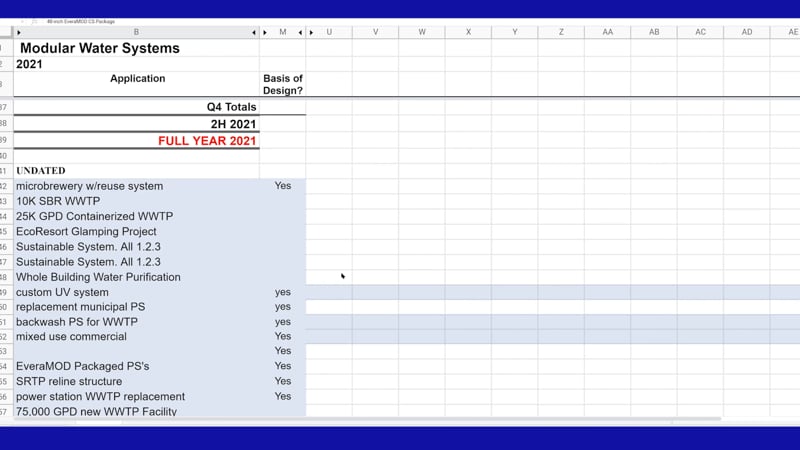
Early Stage Deals
Riggs: Okay, good. Now, I'm looking down here past the full year 2021, and we're keeping that amount a secret, but we're looking here at undated systems. Now, what are these?
Dan: These are opportunities and prospects that are in our pipeline of opportunities. These are customers that have reached out to us. They are at various stages of trying to understand what our capabilities are, trying to understand what their budgeting and cost needs are going to be, permitting needs.
These are ones that are active in our pipeline, but they are very early stage. They're not into the final engineering stage, they're not in the final permitting or into the construction phase, very early stage. And as you can see, there are quite a few of those opportunities out there.
Active Viable Prospects
Riggs: Now is it fair to say, even though they're undated, every single deal on his page, these are people you have spoken to, that you have usually made a bid to, and so these are not just names that are thrown on the wall?
Dan: That is correct. These are active, viable prospects and customers. They are. We have had personal conversations, emails, direct contact, direct exchange of information.
Riggs: Does your family ever see you?
Dan: Yeah, not as much as they would like to. Yeah, they see me.
Sales Cycle Drawn Out
Riggs: Okay. So, what you and I have been living through since you joined us in mid 2018, is this enormous backlog of potential deals. Everything technically is good. We don't show basis of design here, but once you achieve basis of design, that's usually when it ends up being dated. So you've done all this work, you've become basis of design, you've talked to all these engineers, and the cities, and this and that and the other thing.
Then, we live through the holding our breath for however many months for the deal to happen. And that's really what kills our margins, isn't it? I mean, this is where staff time starts really eating into the profits for these deals.
Dan: It can. It can. There are certain phases of a project sale, what we would call the anatomy of a sale, that you've done all your paperwork, it's out of your hands, it's in the hands of the permitting agent or it's in the hands of the customer to sign the contract and to commit to the thing. So there is that element that comes with the water system delivery.
Single Point of Contract
Riggs: Okay. So there's roughly, at a glance, there's 100 deals here. So you're telling me that out of these, maybe 30 would pop if we had pre-funding for them, right?
Dan: Correct. I truly, truly believe that, just because in the private sector, because it's unencumbered, there's no accountability relative to the private owner entity, they get to spend their money however they want to, they're not beholden to public procurement law like a municipality is.
Riggs: Sure.
Dan: So in those instances right there, if they recognize that a DBOO model, a design-build delivery model is more appropriate for them, and is more efficient, and more effective and affordable, that's the path they want to go.
They want a single point of delivery, a single point of contract, all of us sign on the bottom line, write one check. That's what they want to do. This model we have is, in my opinion, the most cost-effective way of delivering water and wastewater to the end users that need it.
Farming Out the Work
Riggs: Well, here's my next question. A third of these things come through, can you deliver to all those?
Dan: That's going to be a question now, that's a question for the CEO, the chief engineer, and the chief operating officer. Scaling and manufacturing will become other issues at that point that we'll need to talk about. Selling will not be the problem. Delivering will be the problem.
Riggs: Marc Stevens will be tearing his hair out. He'll look like me after a while.
Dan: He will. That's right. He will, he will be stressed.
Riggs: Well, the good news is...
Dan: That's a good kind of stress.
Riggs: Well, here's the thing. Tom Marchesello and I, we're at corporate, right? Obviously, we default the business to Progressive Water in Texas, but we're just as capable of farming it out to another company, AdEdge in Atlanta, or any one of these other companies that we love, really they're wonderful companies.
Certified Systems — A Gold Standard
And so, really what we can do is from our dashboard, our control panel, we're able to farm these out. And this is where we come to a critical part of the model, which is, certifying solutions. And on our new Water on Demand focused website that we're building, there's going to be a gallery of the Water on Demand certified systems, that you have signed off on, after thorough review.
So, we know that obviously, Modular Water, the ones you've built, we believe they'll be certifiable. And a number of the PWT ones will be also. But let's say AdEdge comes up, AdEdge, for example, has a good modular business, especially in places like India.
And so, let's say they come up with one and you would then look at it and go, "Okay, if you fix this and this and this, I can certify it." And then it would go up on the site and be one of the choices. And that, I think, would be so cool because we would have a gold standard for Water on Demand systems. Kind of cool.
Workability of DBOO Model
Dan: Riggs, I totally agree with that. While we have, we're very proud of what we do internally here at Modular and Progressive in manufacturing capabilities, a one size fits all model does not necessarily apply to all customers. There are systems out there because of size, we just may not be able to accommodate that.
In that instance right there, going to another qualified vendor that can deliver the equipment. It's still, it works beautifully under this model. We can make it work. That is another slick aspect of this DBOO model.
Moving Beyond DBOO
Riggs: Okay. So, understood all that. Now the final point that I want to get into is, I don't know if you heard about the Innovyze sale to Autodesk this week. Innovyze is a water infrastructure software company that got sold to Autodesk who make AutoCAD. And it allowed Autodesk to be end-to-end design all the way through asset management, real time, network management, all that good stuff, by acquiring Innovyze.
Now that was great, it was a billion dollar sale. Innovyze became part of Autodesk for a billion dollars. We have many of those strengths right here in first of all, of course, your license technology. But then you have the software that I used to call, manna, I remember, manna. Manna from heaven.
And so, there's your software. And then there's your various trade secrets, which are the standardized systems that you built and all that good stuff. And in a way, this is a micro Innovyze. It's a way to provide that infrastructure software. Am I right?
Dan: It is. It is. There are a lot of similarities. What you just mentioned there with the Autodesk, with their acquisition of Innovyze. That, I see a lot of similarities to what we do.
Kicking WaaS up a Notch
Riggs: That's very cool because if we're going to move beyond DBOO into Water-as-a-Service, which we then kick it up a notch into Water on Demand, by adding those modular systems, the rollout systems and your design and management capability. And then we start offering pay by the cubic meter or by the gallon. Well, we need to have network management. Those sensors need to be reliable, or we won't get paid. Right.
Dan: Sure.
Riggs: And then, how does that flow? And we're going to get into one of our investors, Ricardo Garcia, he ran the managed services business for HP's conferencing system back in the day. And he said, "Call on me because it's a technology. Managed services is a whole thing. And if you don't scale it up, then it all gets constipated and it's chaos."
So, we're entering an interesting phase, but the good news is I believe that, with your help, we have the building model. We're getting the money. We have the good systems, but we also have the web of design and monitoring capability that we're going to have to have. And I think that, we're in an exciting place. Would you agree with that?
Managing a Water Technology
Dan: We are. We are. My comment on that one too, is that with the design-build-own-operate model and in today's world where we live with internet telecommunications capability with everybody plugged in, all of our treatment systems, all the infrastructure systems that we deliver, whether they're ours or somebody else's, they will have that integrated capability, that telecommunications capability.
And that, from an operational standpoint and from a confidence building standpoint, really allows us, as the operator of these systems, to know exactly where our assets are, know what condition, what state they are in. We can be more effective and be more responsive in preventative maintenance and service and all the things that come with managing a water technology that's being used by one of our customers.
Making it Happen
Riggs: Wow. Well, with that, I know that you got a meeting to go to. I am so excited by how this is pulling together. We've been working for years to make this happen and with the support of our amazing investors, we're there. And it's all clicking. I'm loving it.
So, good luck to you tonight. Don't be a stranger to your family. And be well. And I really appreciate your time tonight. It's been super, super helpful.
Dan: Riggs, my pleasure. Great to be with you again. Good to see you. Take care. Have a good evening.
Riggs: Thank you, Dan. And a good night.
End of video presentation
About Our Regulation A Offering
Wow. That was a super cool session. And I have, before I go on with the rest of the PowerPoint, I'm going to see here.
Okay. Bitcoin Debut wants to know, "Are you guys still offering a Reg A+ offering?" Yes, we are. And that red band along the top at originclear.com click on that. Identify yourself as an unaccredited investor and join us. And it's really a great offering. Fantastic. Because remember, we are building a capital game here, and this is basically, a bond with 10% yield.
And then, when we decide to redeem you, we have to pay you $150 for every $100, which is great. So, I strongly recommend that. Just go to our website and click on the learn more when you go through that. And I would love to get your feedback on that. Okay.
And, oh my gosh, "Warning. That signup process is crap. I just went through it." Well, thank you, Bob, for the very good review. I need to hear that feedback. So, thank you. And Bob, we're going to find out exactly what you went through here, because there's something about that..."Devin has the details."
I think what you're talking about is the FundAmerica interface, which is just, it is what it is because it's all automated. Whereas, with our larger investors, we do it by hand. We talk to you and so forth. With FundAmerica, it's a platform we use. The great benefit of that platform is it takes credit cards, which we can't take otherwise.
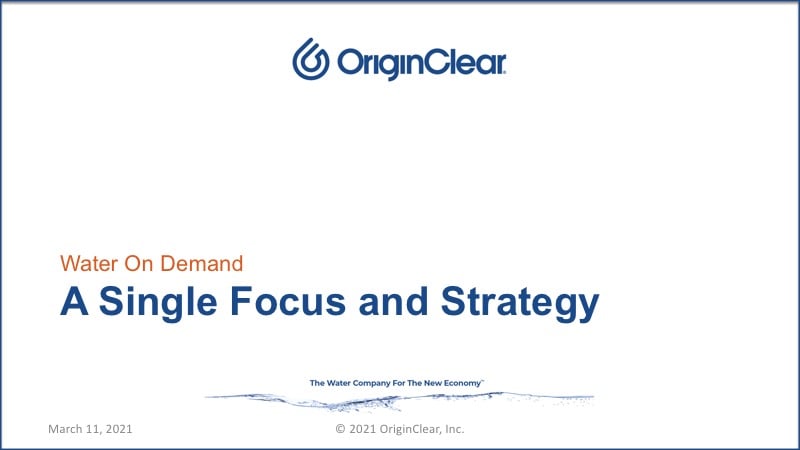
Water on Demand™
Okay. Let me get on with it because time's a wasting here and I'm glad we have so many people on board. So, I'm just going to quickly run through the rest of the show. And Dan was the star and I was super happy to have him on board. Water on Demand. That is now, our single focus and strategy. What does that mean?
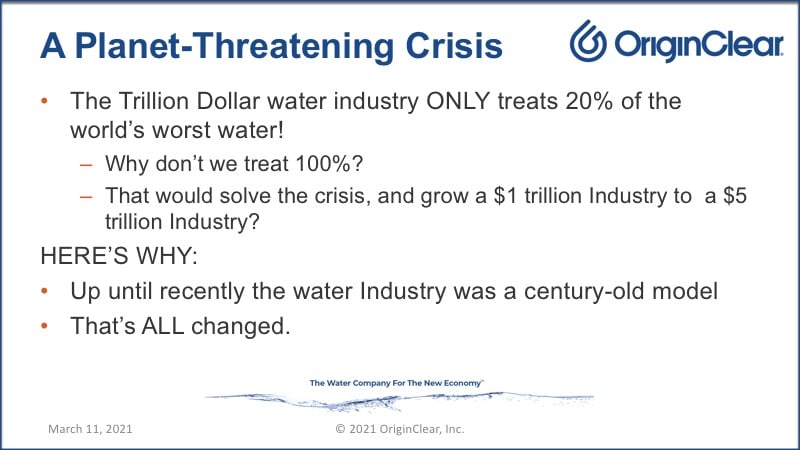
New Presentation
Well, I'm going to do the first few slides from Ken Berenger's amazing new presentation, just as a, give you a little bit of tease.
So, as he says, it's we have a planet threatening crisis. Why? Because the trillion dollar water industry only treats 20% of the world's worst water. Why not a hundred percent? Well, of course, that's five times the trillion dollar industry, therefore a five trillion dollar industry. How come this isn't happening? How come literally four-fifths of the world's dirty water ends up in the ocean and in the groundwater and everything? Because of the unchanged, century-old model, right?
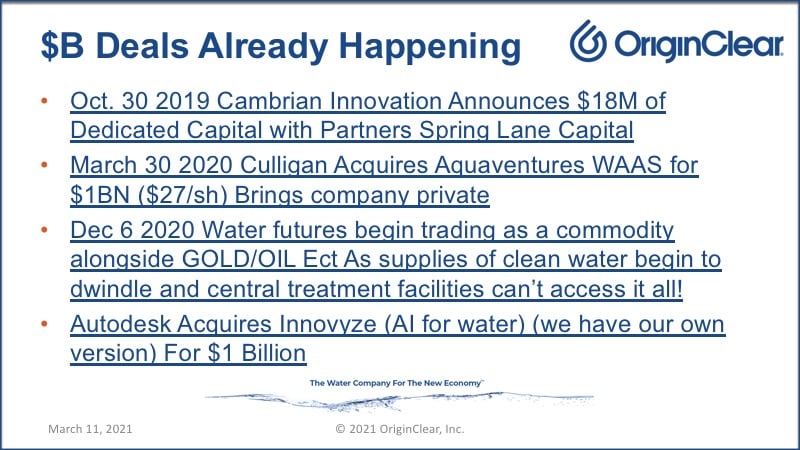
That's All Changed
Now, billion dollar deals have happened. Cambrian Innovation, which is a private company, in 2019, got $18 million to do exactly this. Then Culligan acquired Aquaventures' Water-as-a-Service, that was the ticker symbol for a billion dollars, to brought it private. And that was a huge win for the shareholders. And then we've heard about the water futures trading now, as a commodity, and Autodesk most recently acquiring Innovyze, which is basically AI for water, which as I discussed with Dan, was that same...billion dollar deals, AquaVentures, billion dollars. Innovyze, billion dollars. It's all billion dollars these days, right?
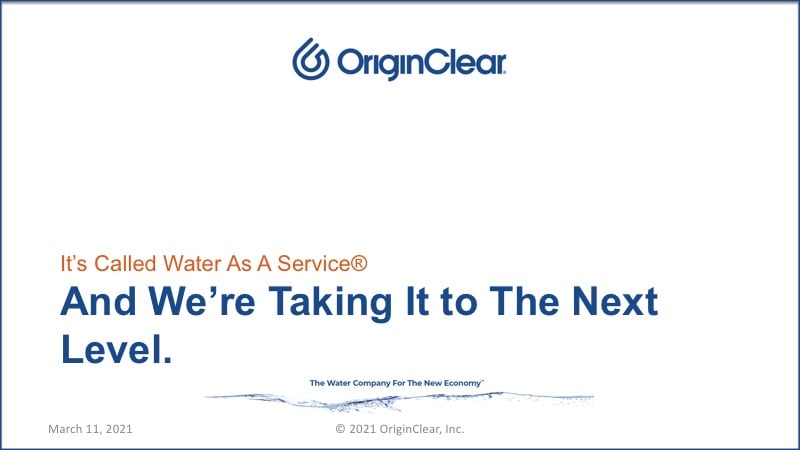
Now that's called Water-as-a-Service. That's a registered trademark of AquaVenture Holdings. So, we can't actually use it as our brand, but we're taking it to the next level. And it's called Water on Demand™.
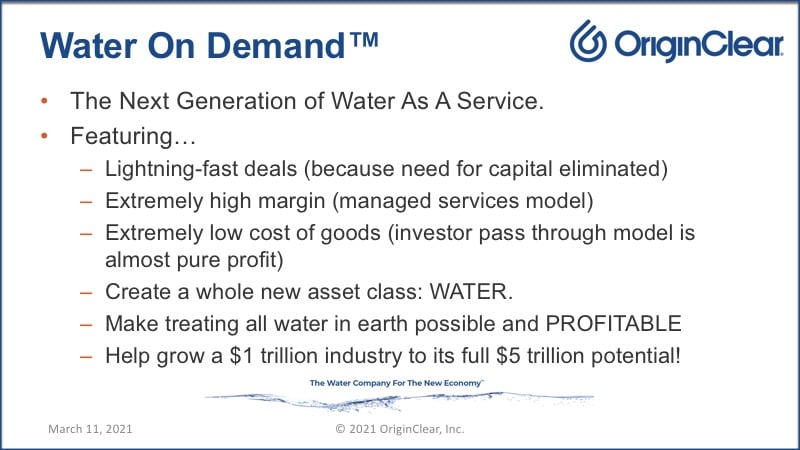
A New Asset Class
It is the next generation of Water-as-a-Service and it features lightning fast deals. Why? Because it's funded. High margin because it's managed services. Extremely low cost of goods because when investors end up investing directly through and that's a future model, then we have very low cost of goods.
We're really creating a whole new asset class with that. We're making treating all the water on earth, profitable, possible, and profitable. Okay. I'm not going to go into this further because Ken's full presentation is coming to us next week.
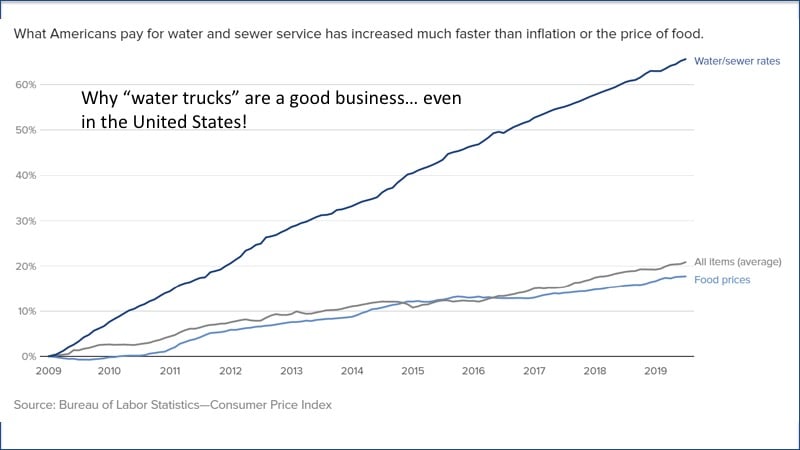
Rising Water/Sewer Costs
I want to show you one last slide, that is super important. This is why water trucks are a good business even in the United States. You would not believe it, but I've been hearing ... we have a new partner who's Pakistani. He knows very, very well. What goes on in Asia, and water is delivered in trucks everywhere.
Our upcoming partner in Mexico, he has got enormous amounts ... imagine this, he's taking water away from factories, 85,000 gallons per day, per location, he's trucking it away to his central water plant. This is ridiculous.
So, really, the way to handle it, of course, is to put the water treatment plants at each location, to treat the 85,000 gallons per day. The treated water goes into the sewer, and only the sludge is taken away by truck. Think of how much trucking will be saved doing that. I won't get into this further, but just think about that. That alone, is an amazing model.
Talk to Ken!
All right, now the amazing Ken Berenger will be ... he's been working with me, of course. Talk to him at OC.gold/Ken. Just put that in your browser. Schedule a call. You will have quite the experience. Please be accredited. Now, if you're unaccredited, you will talk to his team, of course. They're happy to talk to you. But you can also call him directly, or email invest@OriginClear.com.
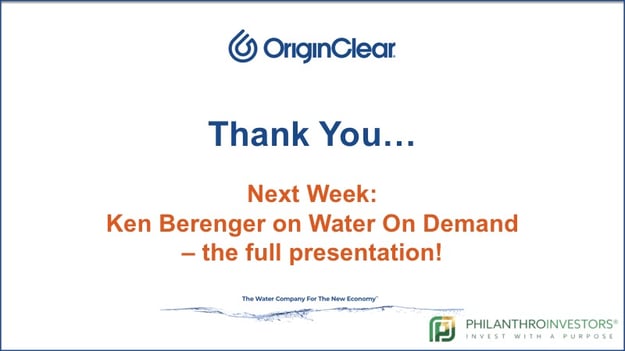
Ken's Wild Presentation
And next week, I want Ken to join us for his hot, wild, crazy new presentation that you will love. And essentially, what it is, is this. DBOO, Design Build Own Operate is a long established technology. It became Water-as-a-Service, which started to trigger billion dollar deals, and now we've taken it the next level of Water on Demand.
And the big, big change there is, we now have these modular truck-in prefab systems with full internet connectivity because AquaVenture Holdings was doing these giant plants, desalination plants. They weren't doing the small ones. That is a challenge. It's a challenge to go small, and we believe that we have cracked that nut.
Thank You
That's it for tonight. Thank you very much, everyone. And it's been wonderful having you. From start all panels, thanks. And thank you. All right guys. Good night, and gals. Have a great weekend. Remember you can always email me through, invest@OriginClear.com. Devin will handle it. And I would love to hear from you. Thank you. Have a great weekend.
Register for next week’s Insider Briefing: HERE
%20250px.png?width=250&height=53&name=OriginClear%20Logo%202019%20(RGB)%20250px.png)

